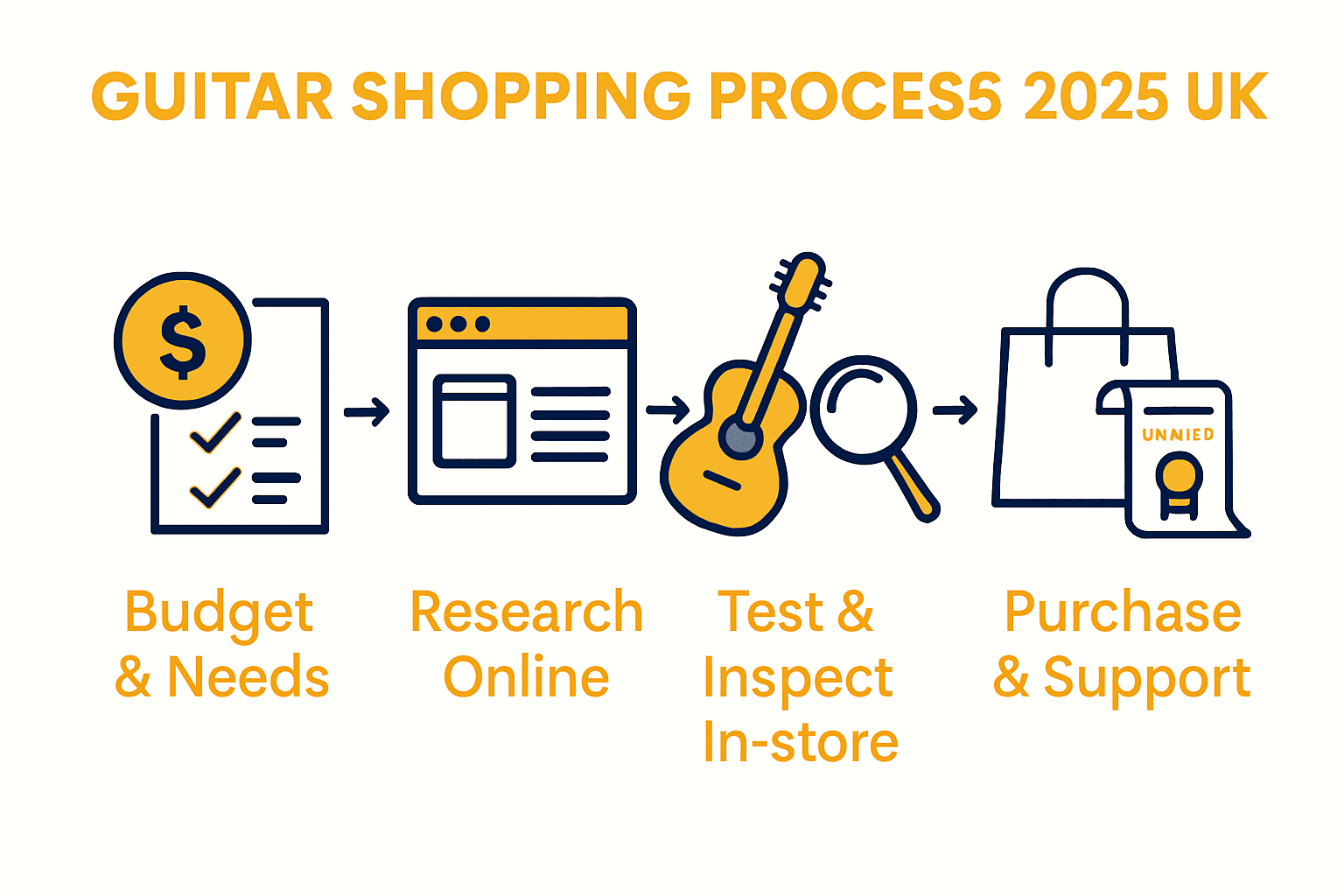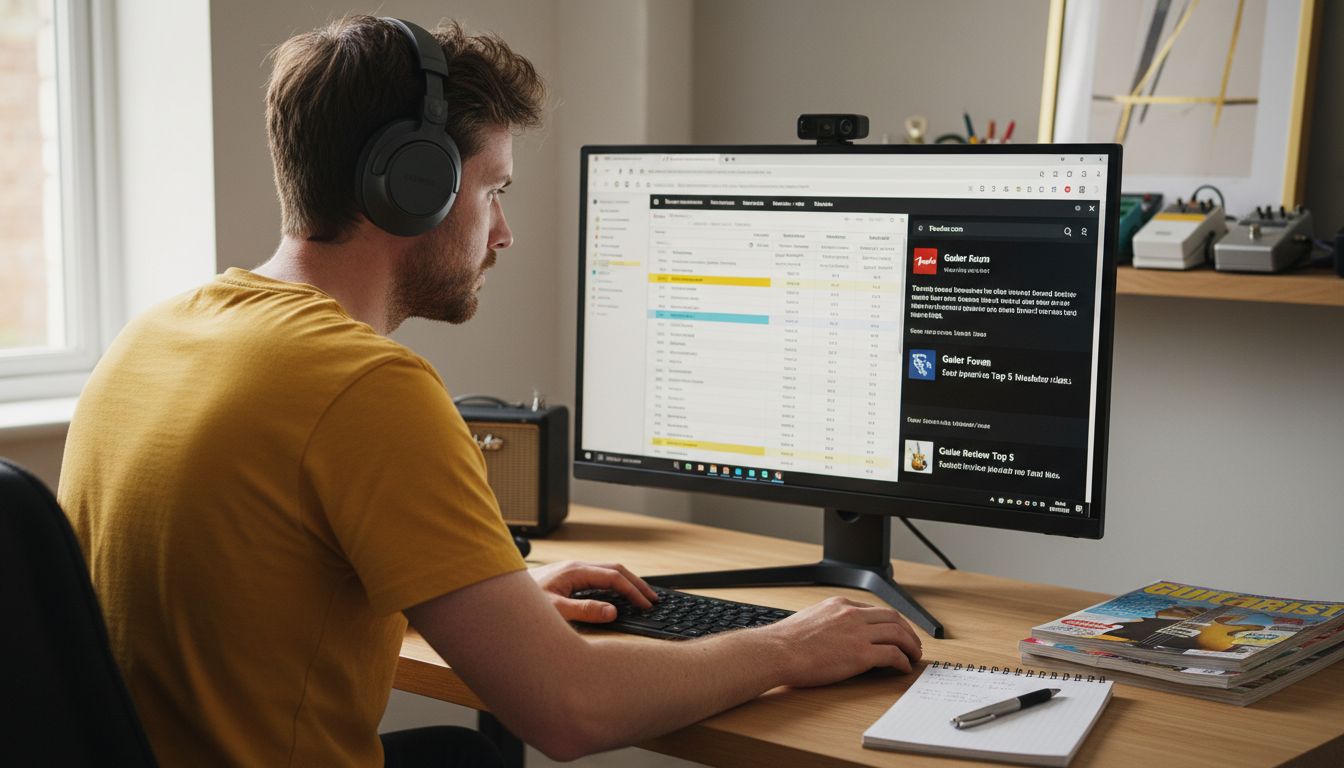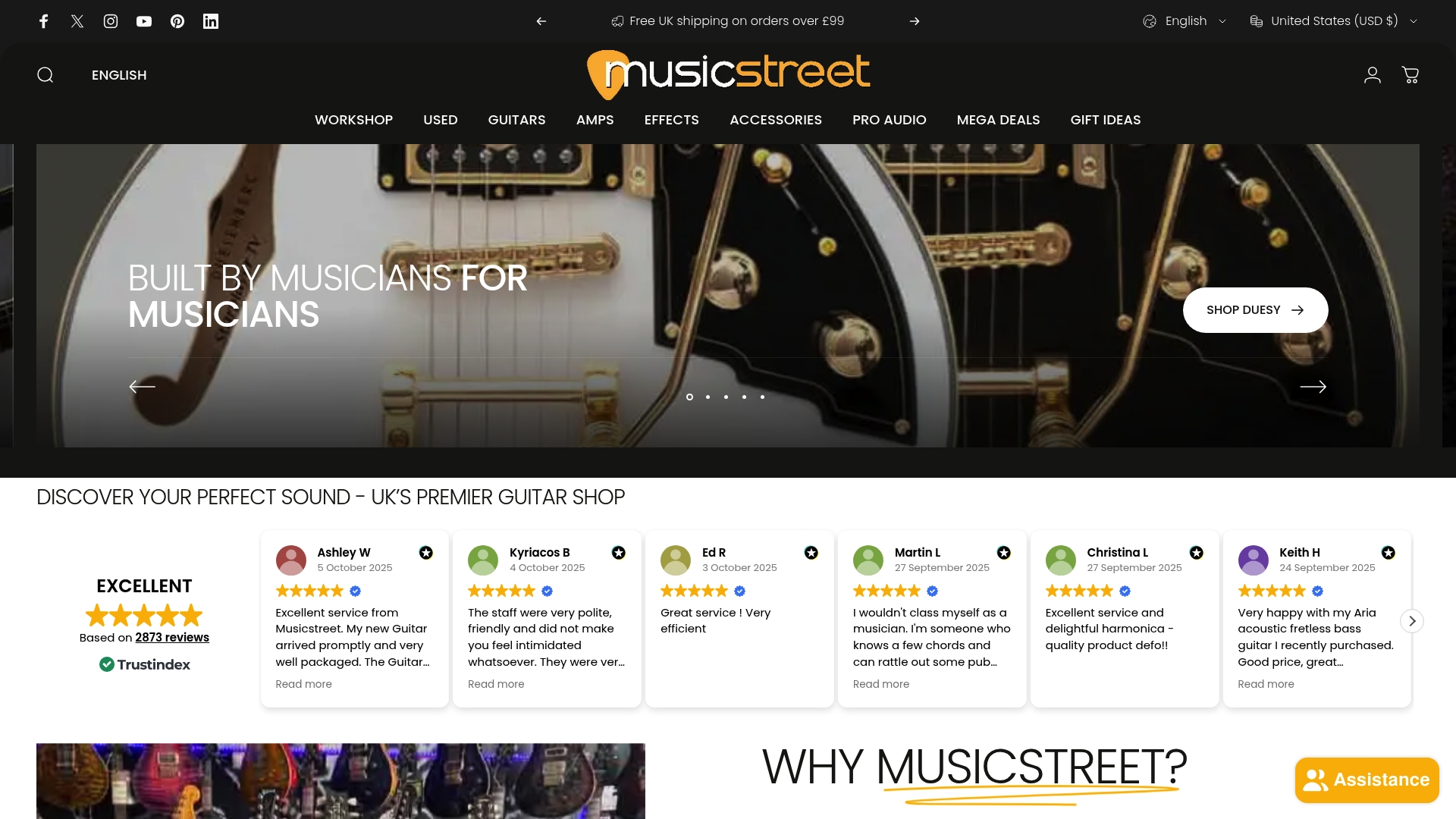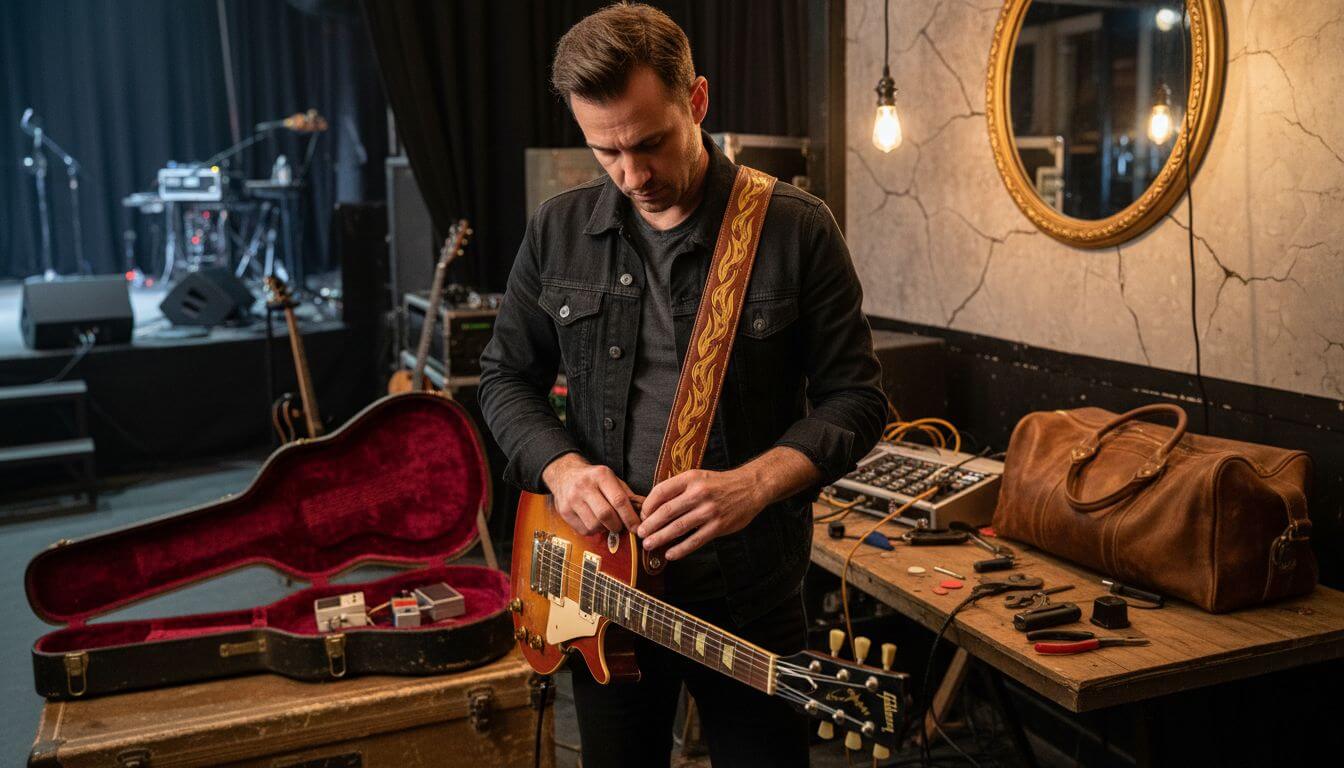Over 70 percent of buyers admit to feeling uncertain when shopping for their first british guitar. Choosing the right instrument means more than just browsing colour or style. Your decision can shape both your musical growth and how much value you get from your purchase. This guide breaks down each key step, helping you confidently select a guitar that fits your goals and your budget.
Table of Contents
Quick Summary
| Main Insight | Explanation |
| 1. Assess your needs and budget | Identify your skill level and budget range, ensuring clarity on what you need to avoid overspending on the wrong guitar. |
| 2. Conduct thorough online research | Investigate different guitar brands and features using multiple sources. Create a comparison to help in making informed decisions. |
| 3. Visit reputable music retailers | Test various guitars in-store to experience their feel and sound, gaining insights from knowledgeable staff about different models. |
| 4. Test guitars for comfort and sound | Evaluate the physical comfort and tonal quality by playing different styles. Prioritise how the instrument feels in your hands. |
| 5. Verify quality before purchasing | Conduct a detailed inspection for structural integrity and component function to ensure a long-lasting investment. |
Stage 1: Assess your playing needs and budget
Deciding to invest in a guitar requires careful consideration of your personal musical goals and financial limitations. Knowing precisely what you need will help you make a smarter purchasing decision and prevent overspending or buying an inappropriate instrument.
According to Musicians Union, musicians should approach instrument shopping strategically. Begin by defining your playing level: Are you a complete beginner, intermediate player, or advanced musician? Each category demands different guitar specifications and price ranges. Beginners might start with more affordable models around £150£300, while professional musicians could invest £1000£5000 for high quality instruments.
Your budget needs realistic calibration with your musical ambitions. Consider factors like: preferred music genre, practice frequency, performance goals, and potential skill progression. The Acoustic Centre recommends testing multiple guitars to understand what truly feels comfortable and matches your sound preferences.
Pro tip: Set aside 10£20 extra for essential accessories like picks, a tuner, and a decent guitar case. These often get overlooked but are crucial for your musical journey. Once you have clarity on your needs and budget, you are ready to start serious guitar shopping.

Stage 2: Research brands and features online
Navigating the digital landscape of guitar research requires a strategic approach to gather comprehensive information about potential instruments. Your online investigation will help you make an informed decision by understanding the nuanced details of different guitar models and their unique characteristics.

PMT Online highlights the importance of thorough online research for guitar buyers. Start by exploring dedicated guitar websites, manufacturer portals, and specialist music forums. Pay close attention to technical specifications such as wood types, pickup configurations, neck profiles, and electronics. Create a comparison spreadsheet to track key features like scale length, body construction, hardware quality, and price points across different models.
Dig deeper than surface level specifications. Watch video reviews from professional musicians, examine high resolution images, and read detailed user experiences. Check technical forums where experienced guitarists share insights about specific models maintenance, sound quality, and long term performance. Look for independent reviews that offer unbiased perspectives on instrument reliability and value.
Pro tip: Cross reference information from multiple sources to build a comprehensive understanding. Online research is your reconnaissance mission before the actual purchase. Your next step will involve narrowing down your choices and preparing for in person testing.
Stage 3: Visit reputable retailers or stores
Transitioning from online research to physical guitar shopping brings your instrument quest to its most critical phase. Visiting professional music stores allows you to experience guitars in ways impossible through digital browsing alone.
Prioritise specialist music retailers with knowledgeable staff and comprehensive guitar selections. Look for stores that offer multiple brands and instrument types, allowing you to compare and contrast different models side by side. Experienced staff can provide invaluable insights into guitar characteristics, helping you understand nuanced differences between seemingly similar instruments.
When visiting stores, adopt a systematic approach. Begin by communicating your musical goals and budget range to sales representatives. Request permission to play multiple guitars, checking comfort, sound quality, and ergonomics. Pay attention to how each instrument feels in your hands examining aspects like neck width, weight distribution, and overall balance. Test guitars through various playing techniques representative of your preferred musical styles.
Pro tip: Schedule store visits during quieter times when staff can provide undivided attention. Bring along a trusted musician friend or mentor who can offer objective feedback about your potential purchase. Remember that in person testing transforms abstract specifications into tangible musical experiences.
Stage 4: Test guitars for sound and comfort
The moment of truth arrives when you physically interact with potential guitars testing their unique characteristics and personal compatibility. Understanding how to critically evaluate an instrument requires both technical knowledge and intuitive musical sensibility.
Acoustic Centre emphasises the critical importance of playing multiple guitars to discover your ideal match. Start by assessing the instrument’s physical ergonomics grip the neck, check its weight distribution, and evaluate how comfortable it feels when seated or standing. Play various chord progressions and individual notes across different fretboard positions to understand the guitar’s responsiveness and tonal qualities.
Musicians Union strongly advises musicians to prioritise the actual playing experience over digital representations. Listen carefully to the guitar’s acoustic and amplified sound testing it through multiple playing techniques representative of your musical style. Check sustain, note clarity, and how different pickup or tonal settings interact with your personal playing technique. Learn to distinguish between instrument characteristics that can be adjusted through setup versus fundamental design limitations.
Pro tip: Bring your own amplifier or request to use a similar model to your home setup during testing. This ensures you hear the guitar’s true voice in a familiar acoustic environment. Your next step involves narrowing down your selection and preparing for a final purchase decision.
Stage 5: Inspect instrument quality thoroughly
Transitioning from sound testing to meticulous examination requires a systematic and detailed approach. Your visual and tactile inspection will reveal critical insights about the guitar’s overall condition and potential longevity.
Musicians Union recommends complete transparency when assessing an instrument’s condition. Start by examining the guitar under bright, natural light checking for structural integrity. Look closely at the neck alignment checking for any warping or unusual bends. Inspect the fretboard for uneven wear, potential cracks, or signs of excessive playing that might compromise playability.
Acoustic Centre emphasises comprehensive visual assessment. Carefully examine the body for hairline cracks, finish irregularities, or signs of previous repairs. Check hardware components like tuning machines, bridge, and electronics for smooth functionality and signs of corrosion. Run your fingers along the neck feeling for smooth fret edges and checking neck joint stability.
Pro tip: Bring a small pocket torch and magnifying glass to conduct a more thorough inspection. Do not hesitate to ask store staff for permission to conduct a detailed examination. Your next step involves comparing your findings and making an informed purchase decision.
Stage 6: Confirm purchase and post-sale support
The final stage of your guitar purchasing journey involves careful negotiation, understanding warranty terms, and securing comprehensive post-purchase protection. This moment transforms your careful research and testing into a tangible musical investment.
Review the purchase agreement meticulously, focusing on return policies, warranty coverage, and potential service options. Request a detailed written documentation of the guitar’s condition, including any pre-existing marks or potential structural considerations. Discuss potential setup services that might be included with your purchase, such as action adjustment, intonation calibration, or initial string configuration.
Ensure you understand the full scope of post-sale support. Ask about manufacturer warranties, potential repair services, and what protection mechanisms are in place should any unexpected issues arise with your instrument. Request a comprehensive breakdown of maintenance recommendations specific to your guitar model. Verify the availability of future technical support and inquire about recommended service intervals.
Pro tip: Keep all purchase documentation, warranty cards, and receipts in a secure location. Digital copies stored in cloud storage provide an additional layer of protection. Your new guitar represents not just a musical instrument, but a long term relationship with your chosen musical companion.
Discover Your Perfect Guitar with MusicStreet
Choosing the right guitar can feel overwhelming with so many specifications, brands, and tonal nuances to consider. This article highlights the challenges of balancing your budget with playing needs, testing for comfort and sound, and ensuring top instrument quality. If you are ready to move beyond research and start playing your dream guitar MusicStreet.co.uk can support you every step of the way. From carefully curated high-end guitars to expert setup and repair services at our Huntingdon store we provide trustworthy guidance and premium instruments designed to inspire.

Explore our wide selection of new and pre-owned guitars with detailed listings and honest customer reviews at MusicStreet. Benefit from personalised advice that matches your musical goals and budget while enjoying the confidence of thorough instrument inspection and post-sale support. Visit us online or in person and take the next step towards making your perfect guitar a reality today.
Frequently Asked Questions
How do I determine my guitar playing level before shopping?
To determine your guitar playing level, assess your current skills and experience. Identify whether you are a beginner, intermediate, or advanced player, and consider how this influences your budget and the type of guitar you need.
What features should I research when comparing guitars online?
When researching guitars online, focus on technical specifications like wood types, pickup configurations, and neck profiles. Create a comparison spreadsheet to help organise this information and track key attributes across different models.
How should I test guitars in-store to find the right fit?
In-store, systematically test guitars by communicating your musical goals to staff, then play multiple instruments to evaluate comfort and sound. Focus on physical ergonomics and request to demo guitars in various playing styles that reflect your musical preferences.
What should I inspect before finalising a guitar purchase?
Before finalising a purchase, meticulously inspect the guitar for structural integrity, checking for neck alignment and any signs of wear. Look closely at both the body and hardware components to ensure the instrument meets your quality expectations.
What post-sale support should I consider after buying a guitar?
Post-sale support is crucial; verify warranty coverage and ask about potential repair services or setup options. Ensure you understand maintenance recommendations for your guitar model to help prolong its lifespan.
How much should I budget for essential guitar accessories?
Set aside an additional £10 to £20 for essential accessories like picks, a tuner, and a good case. These items contribute significantly to your overall playing experience and are vital for maintaining your instrument.



Share:
7 Types of Guitar Straps Every Guitarist Should Know
Complete Guide to Custom Guitar Straps